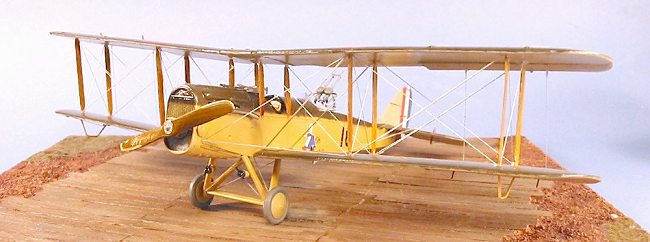
Blue Max 1/48 American DH-4
|
KIT # |
|
|
PRICE: |
$49.95 |
|
DECALS: |
Two Aircraft |
|
REVIEWER: |
|
|
NOTES: |
Short run plastic with pewter detail parts |

|
BACKGROUND |
For a history of the American D.H.4 and a look at the kit, please visit the preview.
Lieutenants Harold E. Goettler and Erwin R. Bleckley and "The Lost Battalion":
The Meuse-Argonne campaign, which began in October 1918, was the major American contribution to the defeat of Germany on the Western Front in the First World War, and was proof that a citizen army, raised and trained in little more than a year, could stand against and defeat the best Europe had to offer. One of the more important stories to come out of this action is the tale of "The Lost Battalion," which later became fodder for more than one history book and several Hollywood movies.
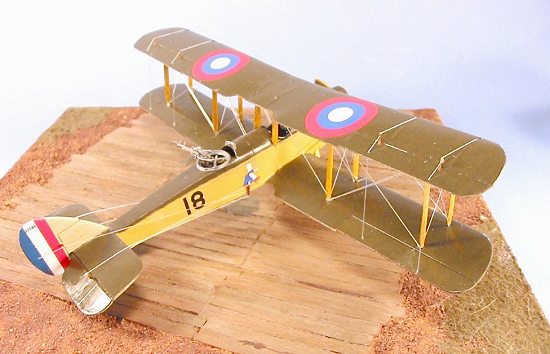 The nickname "The Lost
Battalion" was coined by the war correspondents, and was actually an
oversimplification of the forces involved. The units were two battalions of one
regiment and companies from two other regiments, all part of the 77th Infantry
Division. On October 2, 1918, approximately 700 men were isolated in a pocket
and surrounded by the Germans at Charlevaux Mill in the Argonne Forest. They had
advanced to and remained on their objective, not realizing - due to poor
communications - that the remainder of the division and the other units involved
had been stalled in their advance and retired to the Line of Departure. With
their communications cut off and with only one day's worth of rations, "the Lost
Battalion" endured five days of repeated assaults from the Germans, starvation,
and friendly fire casualties from American artillery, which was attempting to
fire on the attacking Germans with faulty information.
The nickname "The Lost
Battalion" was coined by the war correspondents, and was actually an
oversimplification of the forces involved. The units were two battalions of one
regiment and companies from two other regiments, all part of the 77th Infantry
Division. On October 2, 1918, approximately 700 men were isolated in a pocket
and surrounded by the Germans at Charlevaux Mill in the Argonne Forest. They had
advanced to and remained on their objective, not realizing - due to poor
communications - that the remainder of the division and the other units involved
had been stalled in their advance and retired to the Line of Departure. With
their communications cut off and with only one day's worth of rations, "the Lost
Battalion" endured five days of repeated assaults from the Germans, starvation,
and friendly fire casualties from American artillery, which was attempting to
fire on the attacking Germans with faulty information.
Lieutenants Harold E. Goettler and Erwin R. Bleckley were, respectively, pilot and observer, assigned to the 50th Aero Squadron, which had recently entered combat equipped with the American-built D.H.4. The squadron was part of the effort to pinpoint the location of the Lost Battalion and drop supplies to them. The weather was cloudy with rain, and the thick foliage of the Argonne Forest forced the D.H.4s to fly in high enough that more of the supplies were ending up in German hands than in those of the intended recipients. Over several days of this effort, the 50th Squadron had lost two D.H.4s to German ground fire, and most others had returned to base riddled with bullet holes.
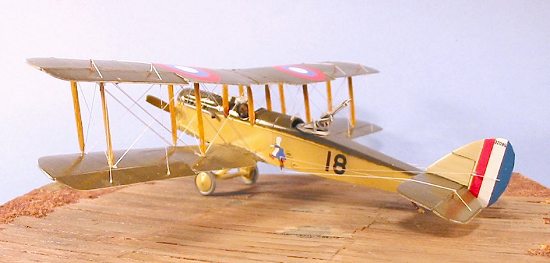 On the morning of
October, 6, 1918, Goettler and Bleckley flew another frustrating mission and
returned from their first sortie with battle damage. After helping their ground
crew repair the damage, they volunteered for a second mission, to be flown at
treetop level - directly into the teeth of the German machine guns. In that
mission, they located and pinpointed the front line traces of both the Lost
Battalion and the surrounding Germans, but both men were badly wounded by ground
fire. Goettler managed to fly out of the caldron of fire, and crash-landed in
the Allied lines. The rescue party found Goettler dead in his cockpit, while
Bleckley died on the way to the field hospital.
On the morning of
October, 6, 1918, Goettler and Bleckley flew another frustrating mission and
returned from their first sortie with battle damage. After helping their ground
crew repair the damage, they volunteered for a second mission, to be flown at
treetop level - directly into the teeth of the German machine guns. In that
mission, they located and pinpointed the front line traces of both the Lost
Battalion and the surrounding Germans, but both men were badly wounded by ground
fire. Goettler managed to fly out of the caldron of fire, and crash-landed in
the Allied lines. The rescue party found Goettler dead in his cockpit, while
Bleckley died on the way to the field hospital.
The rescue party also retrieved Bleckley's equipment. His notes and map annotations allowed the Americans to fire more accurate artillery on the Germans and to mount a relief effort which eventually broke through to the Lost Battalion. Bleckley and Goettler were posthumously awarded the Medal of Honor.
Here are the citations for each:
BLECKLEY, ERWIN R. (Air Mission)
Rank and organization:
Second Lieutenant, U.S. Army Air Corps, 130th Field Artillery, observer 50th
Aero Squadron, Air Service. Place and date. Near Binarville, France, 6 October
1918. Entered service at: Wichita, Kans. Birth: Wichita, Kans. G.O. No.: 56, W.D.,
1922. Citation: 2d Lt. Bleckley, with his pilot, 1st Lt. Harold E. Goettler, Air
Service, left the airdrome late in the afternoon on their second trip to drop
supplies to a battalion of the 77th Division, which had been cut off by the
enemy in the Argonne Forest. Having been subjected on the first trip to violent
fire from the enemy, they attempted on the second trip to come still lower in
order to get the packages even more precisely on the designated spot. In the
course of his mission the plane was brought down by enemy rifle and machinegun
fire from the ground, r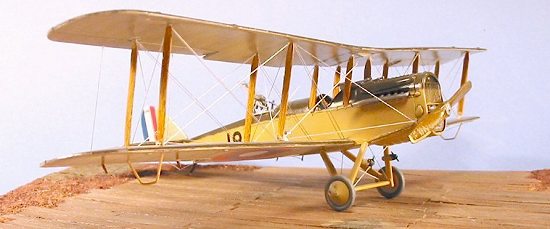 esulting
in fatal wounds to 2d Lt. Bleckley, who died before he could be taken to a
hospital. In attempting and performing this mission 2d Lt. Bleckley showed the
highest possible contempt of personal danger, devotion to duty, courage, and
valor.
esulting
in fatal wounds to 2d Lt. Bleckley, who died before he could be taken to a
hospital. In attempting and performing this mission 2d Lt. Bleckley showed the
highest possible contempt of personal danger, devotion to duty, courage, and
valor.
GOETTLER, HAROLD ERNEST (Air Mission)
Rank and organization: First Lieutenant, pilot, U.S. Army Air Corps, 50th Aero Squadron, Air Service. Place and date: Near Binarville, France, 6 October 1918. Entered service at: Chicago, Ill. Born: 21 July 1890, Chicago, Ill. G.O. No.: 56, W.D., 1922. Citation: 1st. Lt. Goettler, with his observer, 2d Lt. Erwin R. Bleckley, 130th Field Artillery, left the airdrome late in the afternoon on their second trip to drop supplies to a battalion of the 77th Division which had been cut off by the enemy in the Argonne Forest. Having been subjected on the first trip to violent fire from the enemy, they attempted on the second trip to come still lower in order to get the packages even more precisely on the designated spot. In the course of this mission the plane was brought down by enemy rifle and machinegun fire from the ground, resulting in the instant death of 1st. Lt. Goettler. In attempting and performing this mission 1st. Lt. Goettler showed the highest possible contempt of personal danger, devotion to duty, courage and valor.
|
CONSTRUCTION |
If you have a few
World War I models successfully completed, this kit will present no
difficulties. It was in fact one of the easiest Blue Max kits I have built.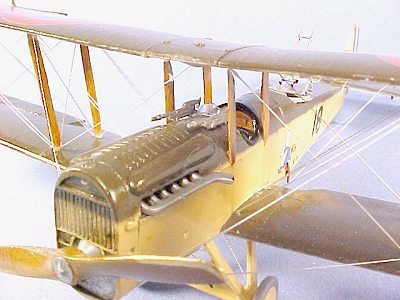
The first thing I did was assemble the three-part upper wing and set it aside to set up, attaching the two ailerons in a "dynamic" pose as I do with most WW1 models. I also attached the ailerons to the lower wings, and cut off and posed the rudder and elevators with the vertical and horizontal stabilizers.
Since the fuselage was built of plywood and only painted inside with varnish, I used some of the new Aeromaster "light wood" decal on the inside of the fuselage halves and the cockpit floor. While I was at it with the decals, I applied the wood decal to the white metal cabane and interplane struts. While all that was setting up, I painted the seats and other detail parts for the two cockpits.
When the decals were dry, I brush painted Gunze Sanyo Clear Yellow over the wood, to give it the varnished look and make the interplane struts look like they were made of ash.
When all this was
dry, I assembled the cockpit interiors. I discovered that the white metal
coaming in the gunner's cockpit was too wide to fit within the fuselage and
ended up cutting it down to just the fore and aft parts and gluing them in
position; once the fuselage was assembled and the Scarff ring fitted over the
gunner's cockpit most of the detail inside
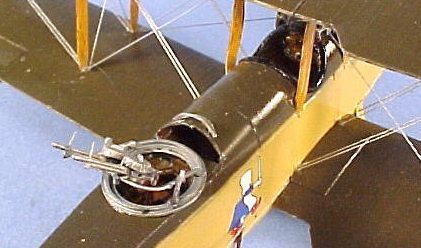 cannot be seen anyway. The
same is true with the pilot's cockpit, which is situated directly under the
upper wing; when assembled one can see the instrument panel and whether or not
there is a shoulder harness on the pilot's seat. Nothing else can be seen.
cannot be seen anyway. The
same is true with the pilot's cockpit, which is situated directly under the
upper wing; when assembled one can see the instrument panel and whether or not
there is a shoulder harness on the pilot's seat. Nothing else can be seen.
I glued the fuselage halves together, attached the white metal radiator, and applied Mr. Surfacer 500 to the centerline seam. When dry, this was sanded down, some Mr. Surfacer 1000 was applied, the fuselage was rescribed where necessary, and the main gear was attached. I had also drilled out the attachment points for the lower wing, and used some plastic rod glued into the butt joint of the lower wings to provide a more solid attachment when it came time to assemble the model.
|
PAINT & DECALS |
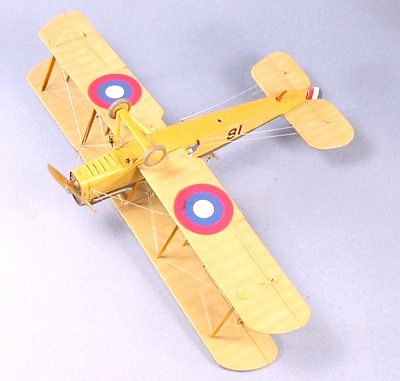 The paint scheme of
the early-production D.H.4 was as follows: upper surfaces of wings and
horizontal stabilizer and upper decking of fuselage: Olive Drab. Lower surfaces
of wings, horizontal stabilizer and vertical stabilizer: clear doped linen.
Fuselage and landing gear: U.S. Army Cream. I used Gunze-Sanyo "Olive Drab (2)"
for the upper surfaces, Gunze-Sanyo "Sail Color" for clear-doped linen, and
Gunze-Sanyo "Cream Yellow" as the U.S. Army Cream.
The paint scheme of
the early-production D.H.4 was as follows: upper surfaces of wings and
horizontal stabilizer and upper decking of fuselage: Olive Drab. Lower surfaces
of wings, horizontal stabilizer and vertical stabilizer: clear doped linen.
Fuselage and landing gear: U.S. Army Cream. I used Gunze-Sanyo "Olive Drab (2)"
for the upper surfaces, Gunze-Sanyo "Sail Color" for clear-doped linen, and
Gunze-Sanyo "Cream Yellow" as the U.S. Army Cream.
First, I pre-shaded the model along all wing ribs and other visible sections of the airframe with flat black. Then I painted the clear doped linen, with the paint thinned 50-50 with rubbing alcohol. I applied sufficient thin coats to just cover the underlying pre-shading, to give a "shadow" effect. I added a drop of white to the paint to lighten it and went back over those areas in between the ribs. Second, I painted the fuselage U.S. Army Cream, again lightening the paint with white for post-shading so it was not a uniform single color. Finally I painted the upper surfaces with olive drab, again applying it thin so that it just covered the underlying pre-shading. When everything was dry, I gave the model three light coats of Future.
The decals were thin and went on easily under a coat of Micro-Sol. When they had set, I washed the model, then applied another coat of Future.
|
FINAL ASSEMBLY |
First I attached the lower wings and braced them to get the proper dihedral. When this was set, I attached the tail surfaces. I then attached the interplane and cabane struts, using cyanoacrylate glue.
Upper wing assembly is always problematic. I generally start at one end, get the struts in the holes, attach with cyanoacrylate, and move on to the next. Once all have been attached and before they have set up, I check alignment with the lower wing, and when it is in position I apply some C-A accelerator with a pipe cleaner to the strut joints to "freeze" them in position.
|
RIGGING |
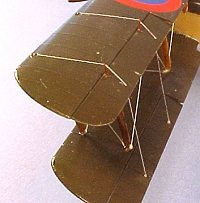 I used .008 stainless
steel wire for the interplane bracing, and did the fairly complicated control
wires to the rudder and elevators with stretched sprue. Here is where you
really need the drawings in the D.H.4 Datafile. The elevator wires are strange,
since the upper wire goes to the control horn on the lower surface, with the
lower wire going to that atop the elevator - this is counterintuitive. Also,
the way the rudder control comes
I used .008 stainless
steel wire for the interplane bracing, and did the fairly complicated control
wires to the rudder and elevators with stretched sprue. Here is where you
really need the drawings in the D.H.4 Datafile. The elevator wires are strange,
since the upper wire goes to the control horn on the lower surface, with the
lower wire going to that atop the elevator - this is counterintuitive. Also,
the way the rudder control comes
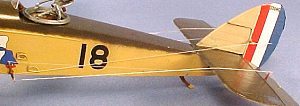 down the side of the
fuselage, then forward to the pilot's cockpit, is unlike any other I have run
across.
down the side of the
fuselage, then forward to the pilot's cockpit, is unlike any other I have run
across.
The trick to rigging with wire is a pair of calipers for getting the measurements, and patience when it comes to positioning them. I had this done in about two hours' effort.
|
CONCLUSIONS |
Blue Max kits are not Eduard when it comes to production quality and ease of assembly, but with "some modeling skill required" and experience in working on World War I models, the end result of the effort is a good-looking model. I think this is the best Blue Max kit to be produced to date, and I have built just about every one of their kits. No modeler who wants a collection American aircraft that includes the truly important airplanes of that history can overlook the American D.H.4.
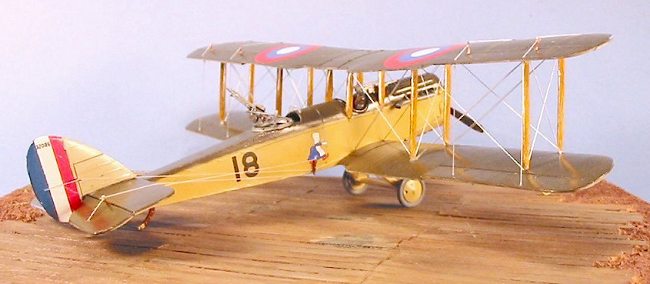
November 2002
Copyright ModelingMadness.com
If you would like your product reviewed fairly and quickly, please contact me or see other details in the Note to Contributors.
Back to the Reviews Index Page